
Creative and inspirational garden ideas with wood
A treasure to be used in a thousand and one ways!
Contents
Among the materials used in the garden, wood stands as a timeless classic and a reliable choice. Whether chosen for garden furniture or the shed where tools are stored, for mulching pathways or crafting an insect hotel, wood naturally finds its place in our outdoor spaces, as an extension of the surrounding plants.
At home in every garden, let’s explore how wood remains the preferred material for many of us in terms of landscaping, how to choose, use, and maintain it.
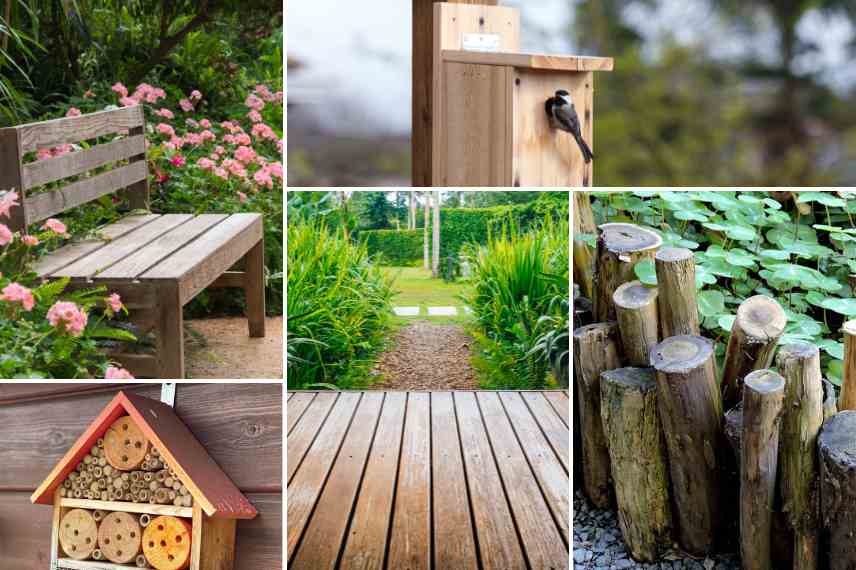
x
Wood: a noble material with many qualities
A noble material indeed, wood has always been valued and used for its intrinsic qualities: warmth in appearance and touch, rich colours, grain patterns, and incomparable aesthetics. Favoured as a traditional construction material in architecture, for sculpture in art, it has also been a staple in gardens for centuries.
Less durable and long-lasting than wrought iron or stone, wood has some drawbacks in the garden, but also many advantages:
The benefits of wood for garden use:
- A warm and aesthetically pleasing surface.
- Wood always blends seamlessly into a garden’s decor: it naturally complements the surroundings.
- The variety of species, from resinous to exotic woods.
- Its versatility and adaptability in both shape and type, fitting all garden styles, from natural to contemporary.
- Finishes ranging from raw to oiled, stained, varnished, or painted.
- It ages beautifully, developing character over time.
- A renewable resource, often locally sourced—even from one’s own garden—it’s an exceptionally eco-friendly material.
- Easy to work with using basic tools, wood allows DIY enthusiasts to unleash their creativity.
- Its decorative appeal for many garden objects and structures.
- Wood pairs effortlessly with other materials: stone, terracotta, wrought iron.
- Potential for upcycling (pallet wood, pruned branches for structures…).
- Relatively affordable compared to other garden landscaping materials.
Its minor drawbacks:
- Wood requires priming or treatment, such as staining or painting, to make it less permeable to water and more durable.
- Maintenance involves storing and protecting it during winter.
- It can be heavy to move for certain furniture pieces.
- It’s less suitable as a container unless lined with a waterproof sheet.
- It can be expensive for so-called noble woods, with prices rising sharply due to growing demand among homeowners.
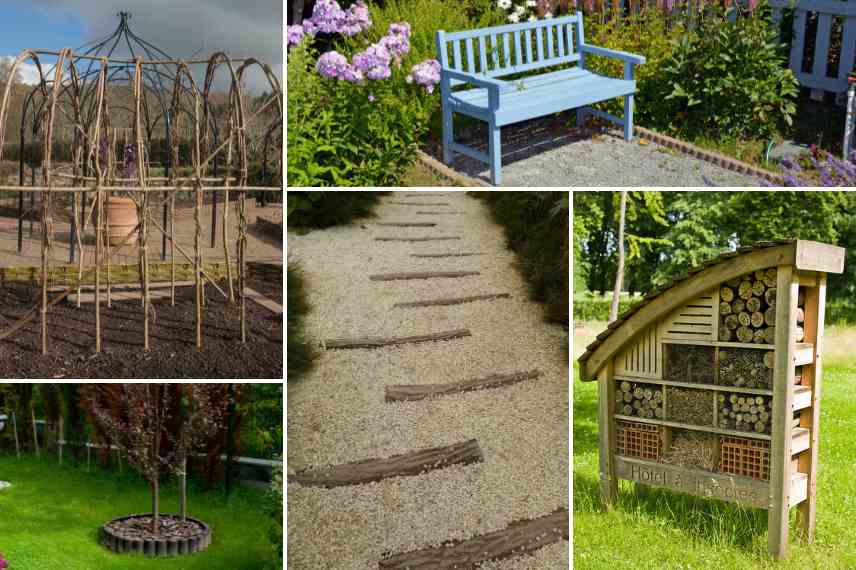
Versatile, wood can be part of any garden project
Read also
How to make a living willow hut?Which wood to choose for the garden?
The essential oils of wood are countless, though those used in landscaping are somewhat fewer. Greater durability is naturally sought, as outdoor wood is exposed to the elements. The woods used in landscape design are therefore selected for their durability among those with high density.
The choice of wood species will primarily depend on the intended use, exposure to the elements, as well as budget and desired aesthetics—woods vary in colour from light to more orange-toned. For outdoor use, it is essential to choose durable wood, classified according to its resistance to moisture and fungi (from class 1 to 5).
Resinous woods, such as Douglas fir, fir, or spruce, are affordable, easy to work with, and ideal for lightweight structures. However, their natural durability is limited: they require insecticidal and fungicidal treatment (pressure-treated) to withstand fungi, insects, and moisture outdoors.
Local leafy woods (oak, chestnut, ash) are more durable, sometimes naturally resistant, and offer good value for money. Chestnut, for example, is perfect for rustic fencing or trellises. Note that black locust wood is one of the few European woods naturally resistant without treatment, class 4: an excellent alternative to teak and eucalyptus sourced from the other side of the world! Its dense, tough wood is perfectly suited for outdoor uses: fencing, furniture, decking, or edging.
Exotic species (teak, ipe, cumaru) are naturally rot-resistant and highly aesthetic, ideal for decking and high-end furniture. However, their environmental impact due to importation remains a consideration.
Increasingly popular, thermally modified or retified woods (ash, poplar, or beech) offer an eco-friendly alternative. Stabilised at high temperatures up to 240°C, they become highly resistant without chemical treatments. As the UNEP highlighted in 2021, “thermal modification techniques that enhance wood’s resistance to rot and climatic hazards are (…) gaining traction. For instance, thermally modified ash can be used for decking, or thermally modified pine for garden sheds”.
Lastly, composite woods, made from wood fibres and recycled plastic, are perfect for those seeking a durable, low-maintenance solution for contemporary decking or fencing.
N.B. for swimming pools: quick-drying and less prone to heat absorption than dark stone, wood is the new material for modern pool surrounds, valued for the natural atmosphere it creates. It is also more economical than stone finishes. Non-slip finishes are a bonus for decking and poolside areas.
For a more sustainable garden, always prioritise locally sourced FSC or PEFC-certified woods, or those from French forests.
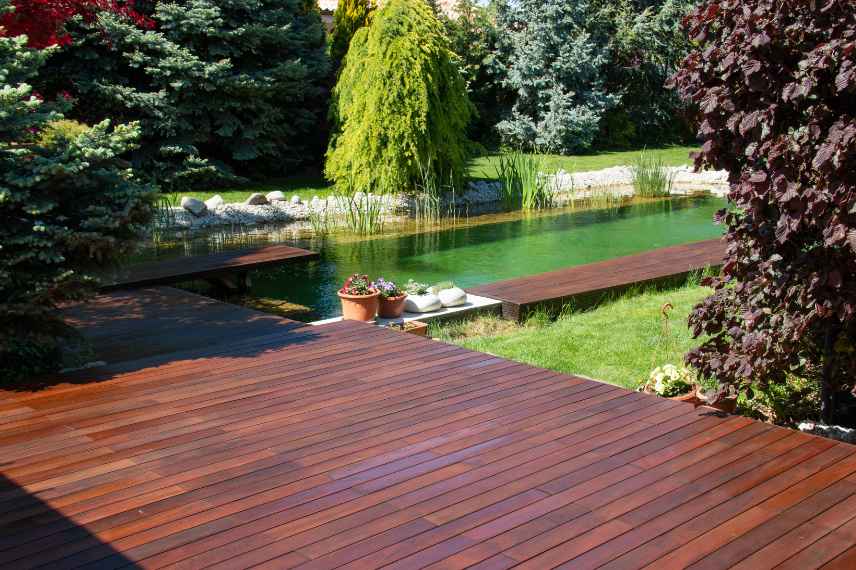
Exotic woods have a darker hue and are often used for outdoor projects
How to use wood in the garden?
Wood brings charm to the garden with a variety of uses and projects, as you’ll discover:
- For garden furniture:
Wooden outdoor furniture remains a substantial offering alongside newer synthetic materials. Layer (benches, armchairs and seats in all styles, iconic Adirondack chairs), tables and garden lounges, recliners, hammocks and sun loungers, side tables and storage chests, sheds and garden shelters. You’ll find furniture at all price points, including high-end teak or acacia pieces.
You can also DIY your own furniture by repurposing wooden pallets. Many books offer step-by-step projects (see below).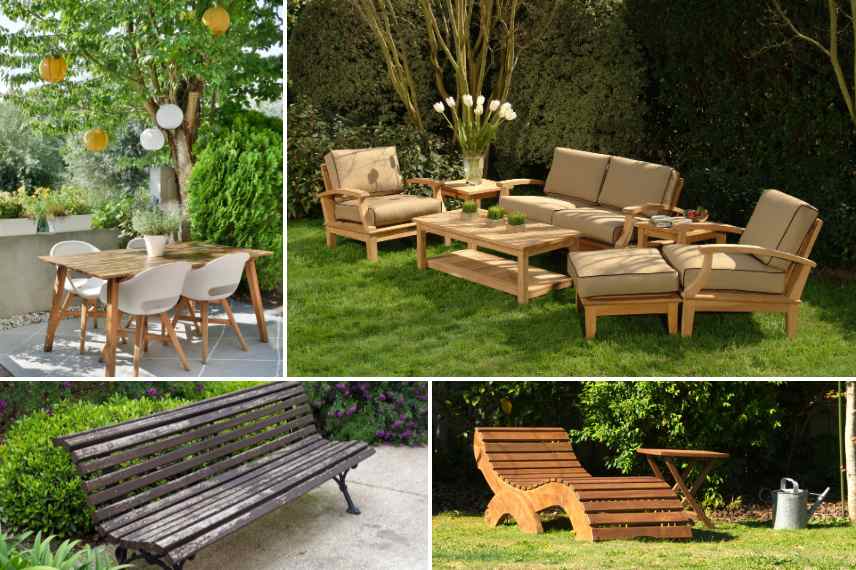
From minimalist designs to curved lines, wood adapts to completely contrasting garden styles
- For creating partitions:
Wood offers numerous screening or semi-open structures: wooden privacy panels, screens, chestnut or hazel trellises, dead hedges, fences, wattle hurdles, as well as arches and climbing plant supports like the classic example below.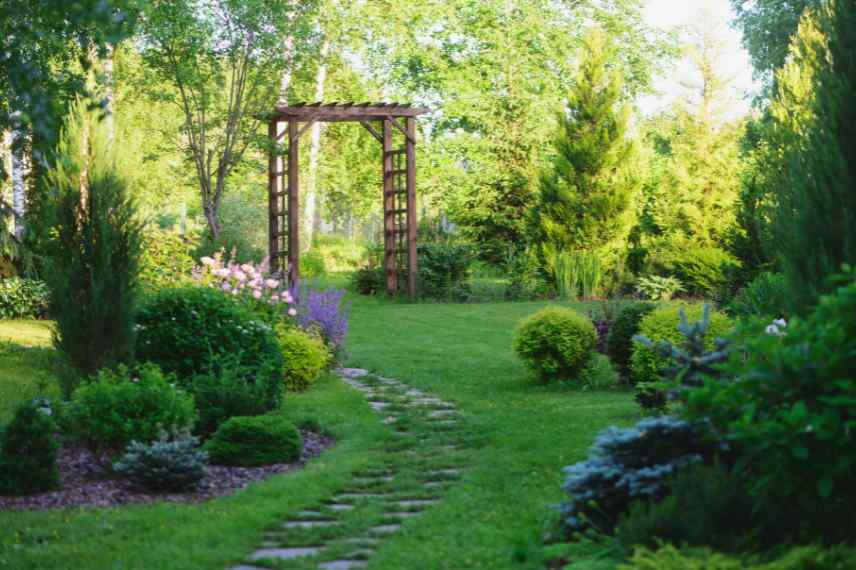
Mini pergolas often serve as romantic passageways in gardens, creating subtle boundaries
- As garden fencing:
Solid fences or picket fencing, rustic wooden gates, ranch-style rails, ornate wooden gates… wood adds a rustic or modernist touch to projects and enhances the desired garden aesthetic.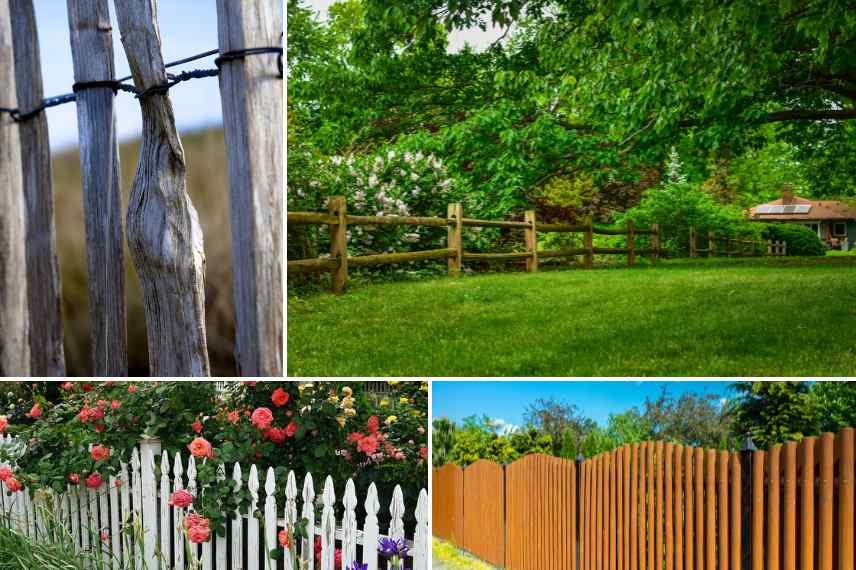
Whether natural or design-led, raw, stained or painted, wood elevates property boundaries (white gate photo ©Pirate renée Flickr).
- For trellises, wickets, pergolas, tunnels and obelisks:
This is wood’s most common yet effective garden use! Available ready-made… or to build yourself with willow, bamboo, hazel or other branches. - As flower bed edging:
Less permanent than steel or synthetic edging, wooden borders are perfect for cottage and naturalistic gardens. Buy them ready-made or craft your own with planks, logs or twigs.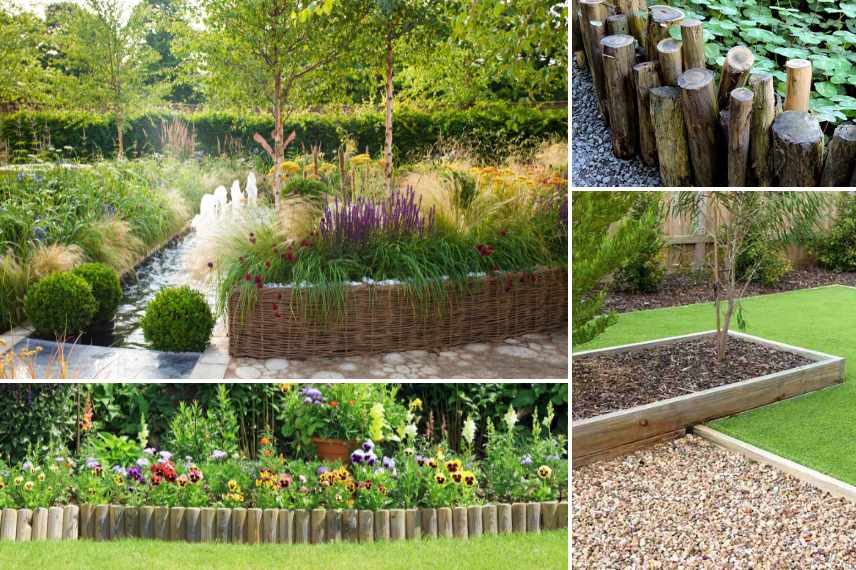
Wooden edging suits various styles depending on shape and wood choice
- As decorative elements – possibilities are endless, from small objects to structures:
Bird feeders and nesting boxes, woven branch screens, gazebos and playhouses, leaning ladders as rose supports, tree stumps as plant stands (see our advice in what to do with a dead tree).
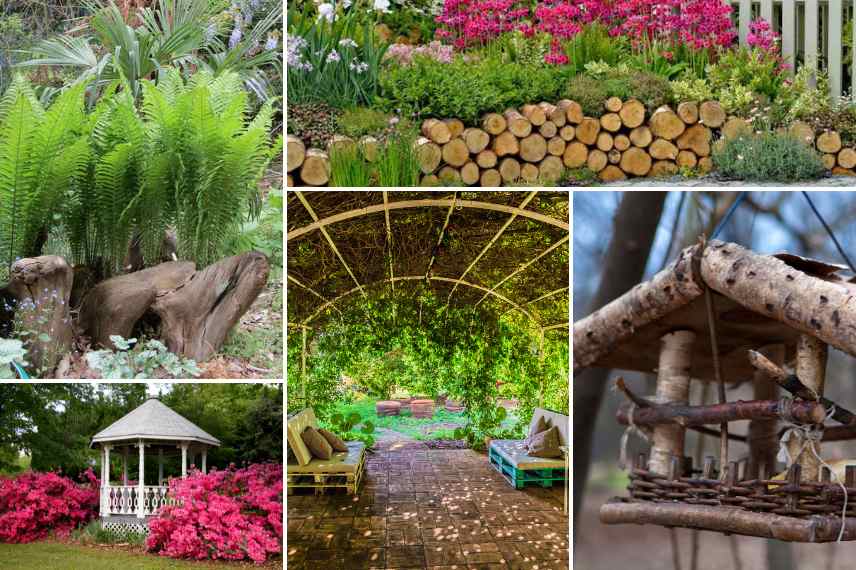
An old stump as a planter (© Leonora Enking), stacked logs, a painted gazebo, a homemade arch or feeder – endless inspiration to recreate
- For landscaping and surfaces:
House terraces, pool decking, wooden frameworks, duckboards, jetties and footbridges in water gardens or flood-prone gardens.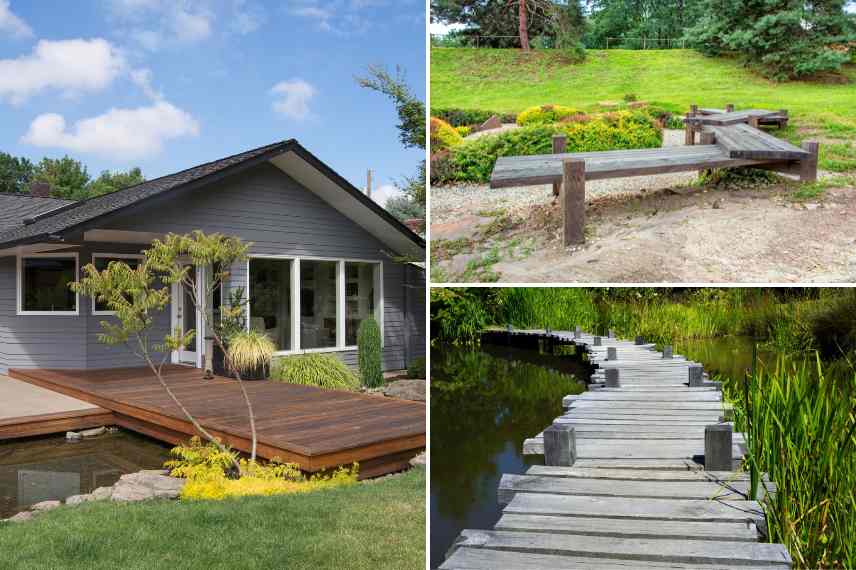
Choosing the right species makes wood ideal for jetties, terraces and footbridges
- As organic mulch:
Path mulching with wood chips, ramal wood (see our guide using wood chips as mulch).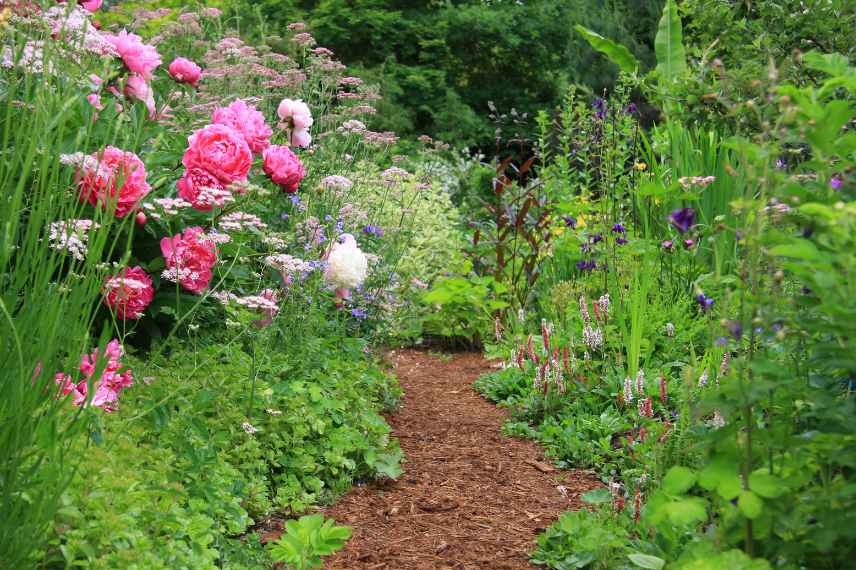
A wood-chip path enhances this idyllic garden scene
- For structures or containers:
With planks, pallets or lined barrels, DIYers find endless ways to create unique planters affordably.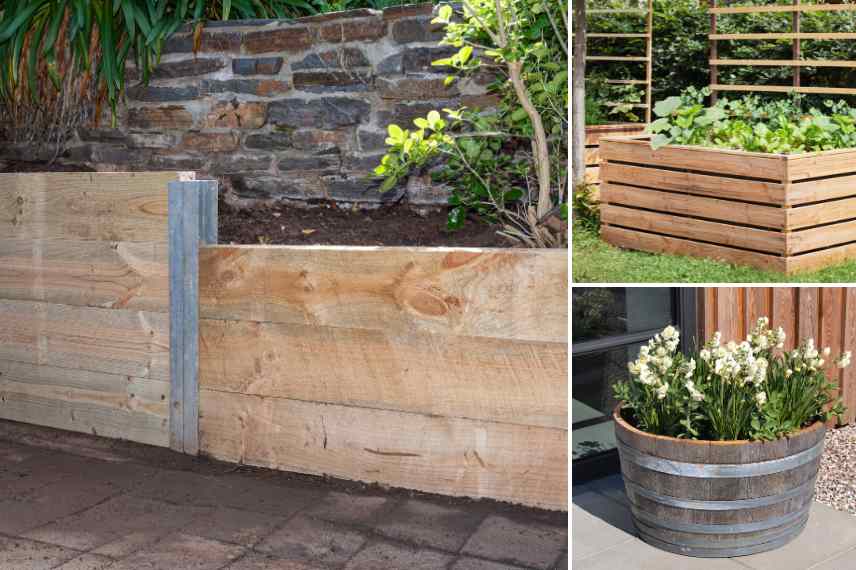
Perfect for crafting raised beds, large planters or upcycled containers, wood is incredibly versatile.
- For biodiversity:
The value of log piles for wildlife is well proven! They shelter hedgehogs and provide refugium for garden insects. - In the kitchen garden :
For building raised beds, stepping boards, compost bins, wooden greenhouses… Also read: How to build raised beds?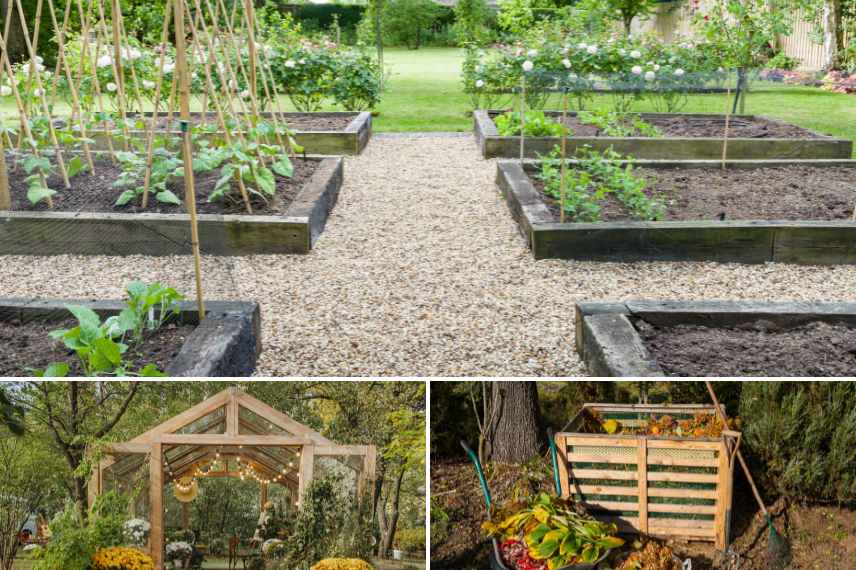
Vegetable gardens love wood!
- For upcycling:
Old stumps become stools, pruning waste transforms into dead hedges (see How to create a dead hedge?), while wood chips mulch beds or enrich compost. - Other wood uses:
Wood also makes homemade plant stakes, posts and poles, beehives, and even retaining walls.
Wood for different garden styles
Choosing wood for your projects is an aesthetic choice that complements various garden styles, blending design, zen ambiance and nature. It’s part of a strong landscaping trend that favours a return to natural materials.
English Garden
In this harmonious and gentle setting, wood takes centre stage, particularly highlighting climbing plants while enhancing an entire romantic universe. With benches, of course, creating cosy resting nooks and alcoves – often paired with wrought iron. Also with wooden arches and obelisks, typically painted in white, blue or green hues, or with wooden fences.
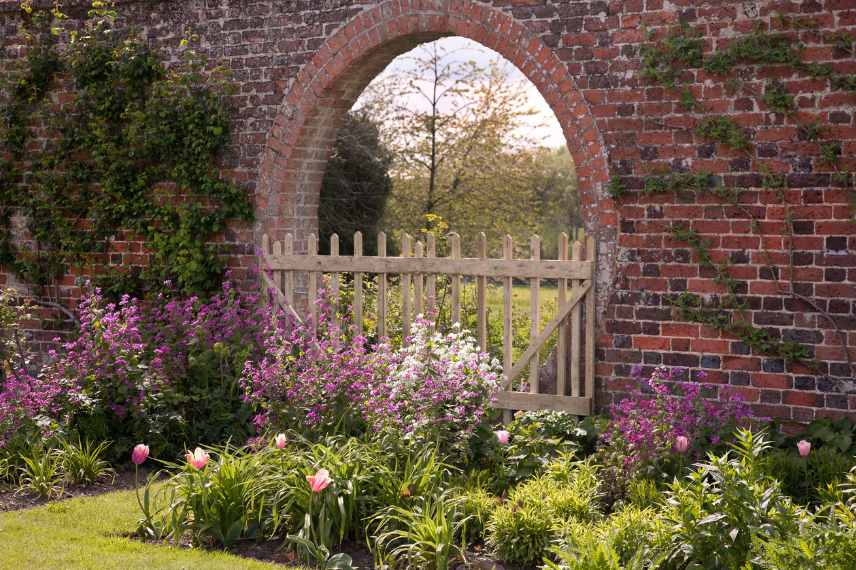
Wood used in fences or furniture always blends beautifully with brick or stone in the English style.
Naturalistic or Country Garden
Here, wood feels most at home as a full-fledged decorative element. Wooden gates and fences lend a bucolic charm, whether rustic or refined. Wood is often used for mulching (wood chips for soft woodland pathways, for example) and can even craft animal-shaped figures from branches.
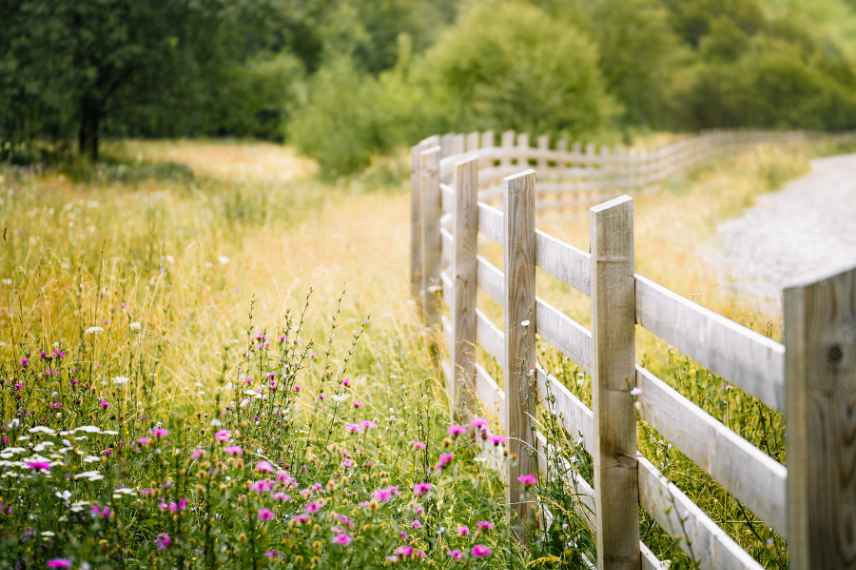
A raw wooden fence encloses the space with countryside charm
Exotic Garden
A teak hammock, a colonial-style bench, or a wooden parasol frame on a terrace are essentials to complement the lush, faraway vegetation.
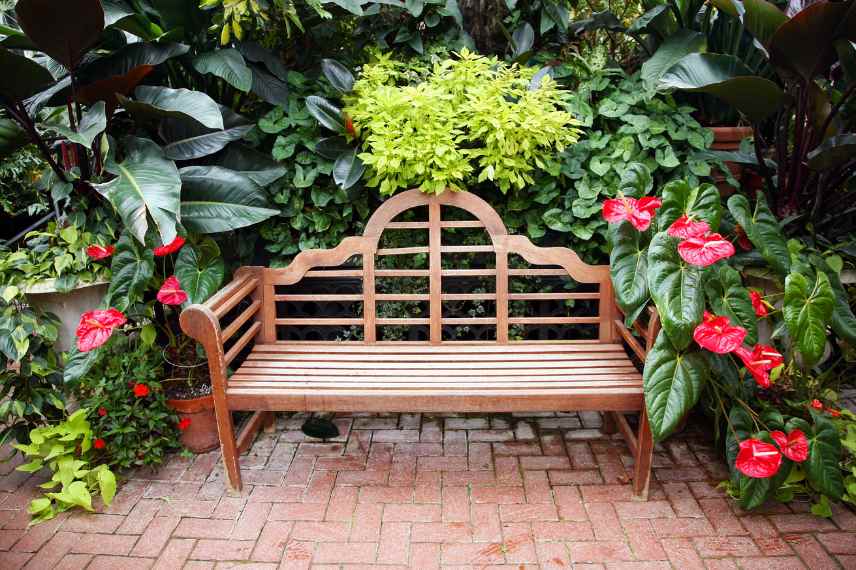
This bench’s style perfectly suits the exotic atmosphere sought in this courtyard.
Contemporary Garden
Here, wood is treated with clean, smooth lines – straight edges and rectangular shapes. It takes on a design-led quality, showcasing another facet of its versatility. Used for exotic wood decking, cladding, pool surrounds, as well as in furniture and openwork fencing, wood in modern gardens is sometimes paired with steel or aluminium.

Cladding, fences, seating and decking: wood warms up all contemporary layouts
Bohemian Garden
Wood pairs perfectly with vintage rattan furniture suited to this garden style. Think loungers like chaises longues, foldable chairs and lattice screens to create intimate corners. Play with eclectic vibes using reclaimed wood.
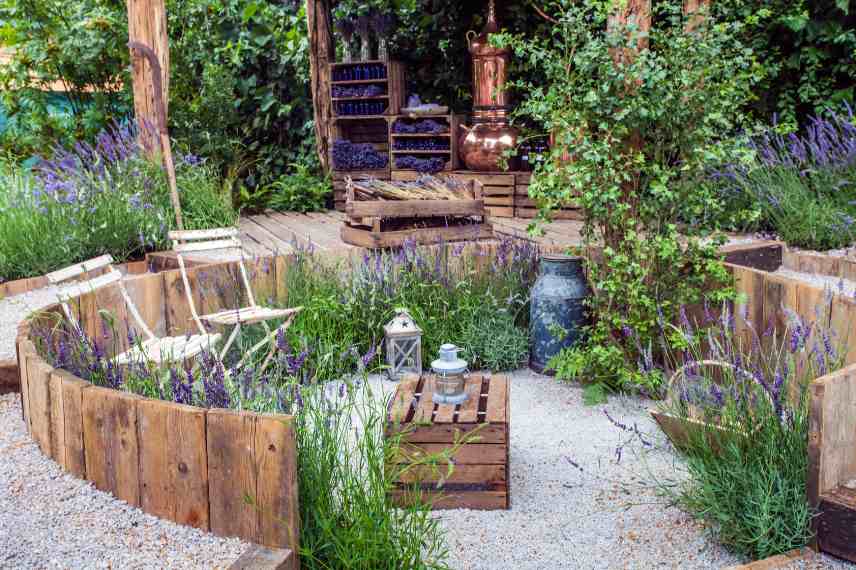
Bohemian gardens mix materials, with wood always present.
Japanese Garden
Though stone dominates, the arched bridge, torii gate and red-lacquered pagoda are essential wooden elements deeply tied to Japanese garden artistry.
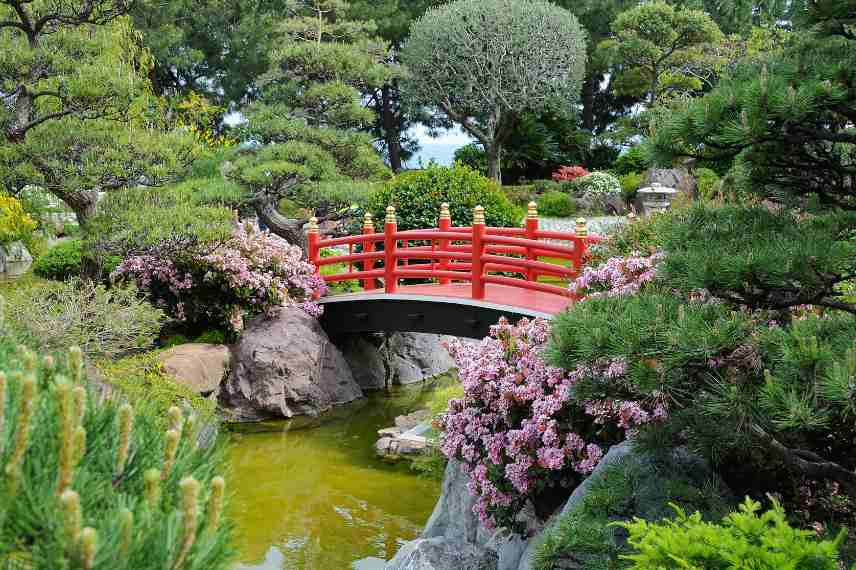
The traditional red-painted wooden bridge (Akai ki no hashi).
Holiday Garden
In a second-home garden, low maintenance is key. Seaside villas opt for practical, clean designs echoing nearby nature.

Harmony comes from wood applied in large surfacing.
Small Garden
Wood creates a snug retreat in compact gardens, adding height with trellises or pergolas.
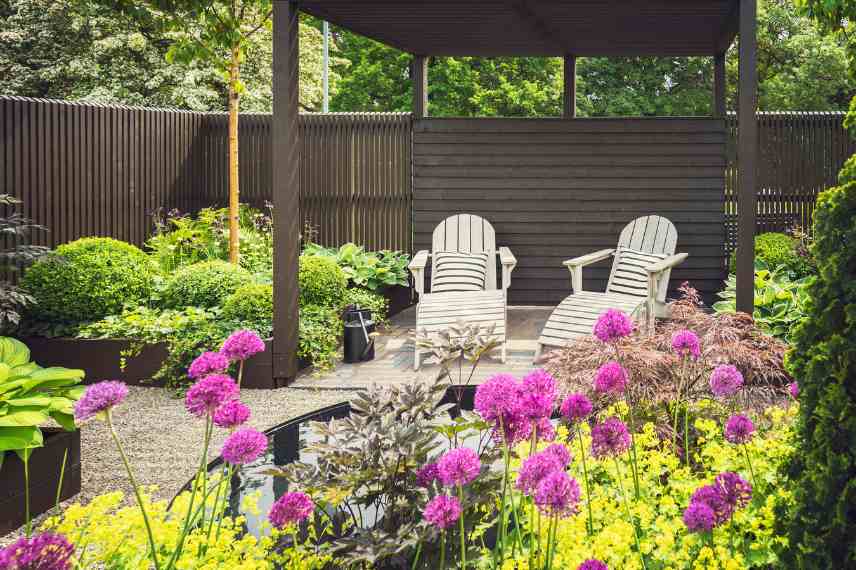
Here, dark wood frames the space, from the fence cladding to the intimate pergola.
Water Garden
As mentioned earlier, decks and jetties adorn ponds or marshes. Larger parks or wetlands can incorporate wooden walkways and platforms.
Complementing a Monochrome Garden
Boldly painting wooden features in strong colours can mirror flower or foliage palettes, whether in a blue, white or pink garden. Wood’s versatility lets it adapt to any vision!
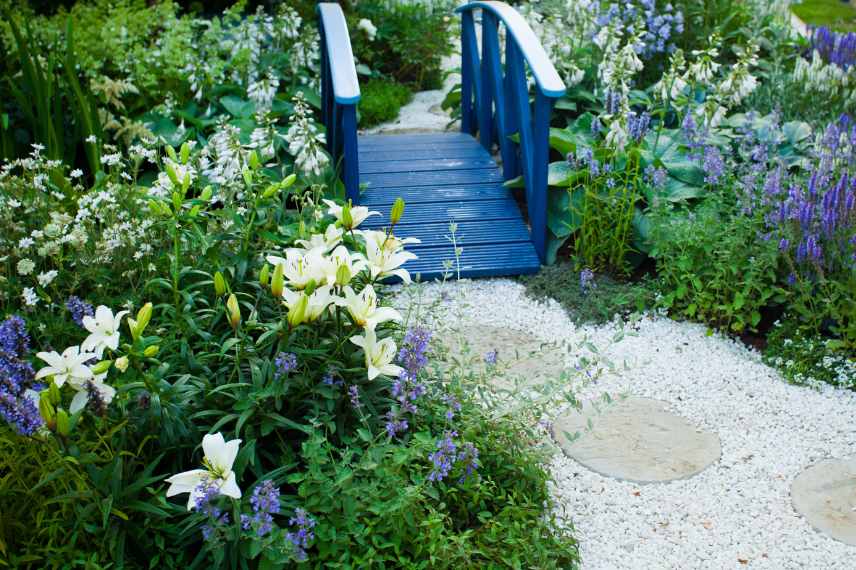
The deep blue chosen for this small bridge echoes the flowering plants.
Caring for wood in the garden: practical tips
The outdoor wood naturally weathers over time due to exposure to the elements. While it can develop an elegant patina, regular maintenance is essential to prolong its lifespan and preserve its appearance.
Garden furniture: daily cleaning with soapy water is usually sufficient. For stains or splinters, lightly sand the surface and then apply a specialised outdoor wood saturator. This type of product nourishes the wood deeply and protects it from UV rays without forming a surface film. Unlike linseed oil, it doesn’t promote darkening or mould growth.
Decking, pergolas, fences: clean once a year with a soft brush using warm water and black soap, or a specialist wood cleaner. Apply a saturator every two years to maintain the original colour and protect the wood from weathering. Avoid pressure washers, as they can be too harsh.
Winter storage: wooden furniture should ideally be stored under cover during winter. If this isn’t possible, use a breathable cover. Avoid airtight covers, especially for exotic woods like teak, which require ventilation.
Remember to check regularly the fixings (screws, nails, joints) to prevent any structural weakening.

Decking requires regular maintenance to retain its warm, attractive colour.
Going further
Several publications have celebrated wood in projects as diverse as they are ornamental!
Don’t hesitate to visit gardens—they always provide inspiration! Stéphane Marie’s garden in the bocage of Cotentin is a place where wood has been used beautifully! Follow me on a tour…
Finally, you’ll learn all about wood industry certifications: the FSC label (Forest Stewardship Council®) and the PEFC label (Programme for the Endorsement of Forest Certification Schemes) guarantee wood sourced from responsible forestry practices.
Do you use wood for other creations? Share your ideas and tips with us!
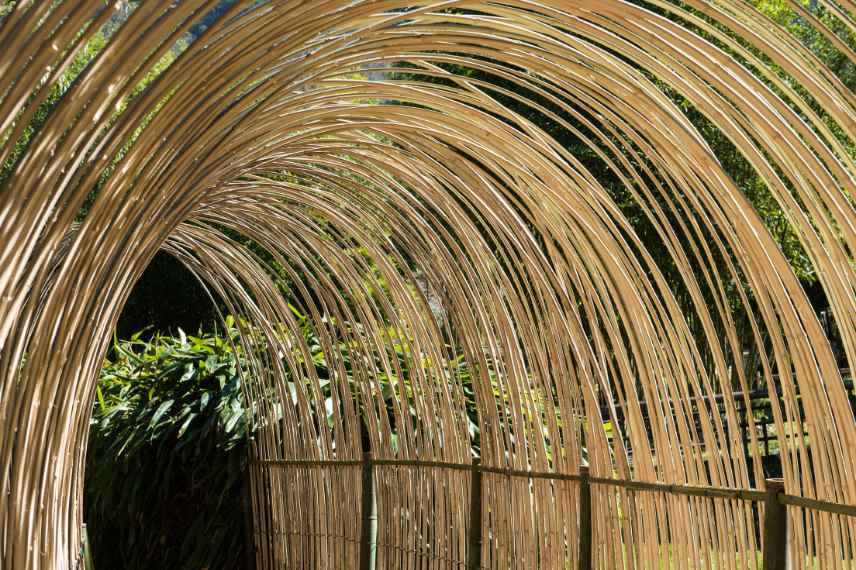
Bamboo tunnel at the Bambouseraie d’Anduze, France
- Subscribe!
- Contents
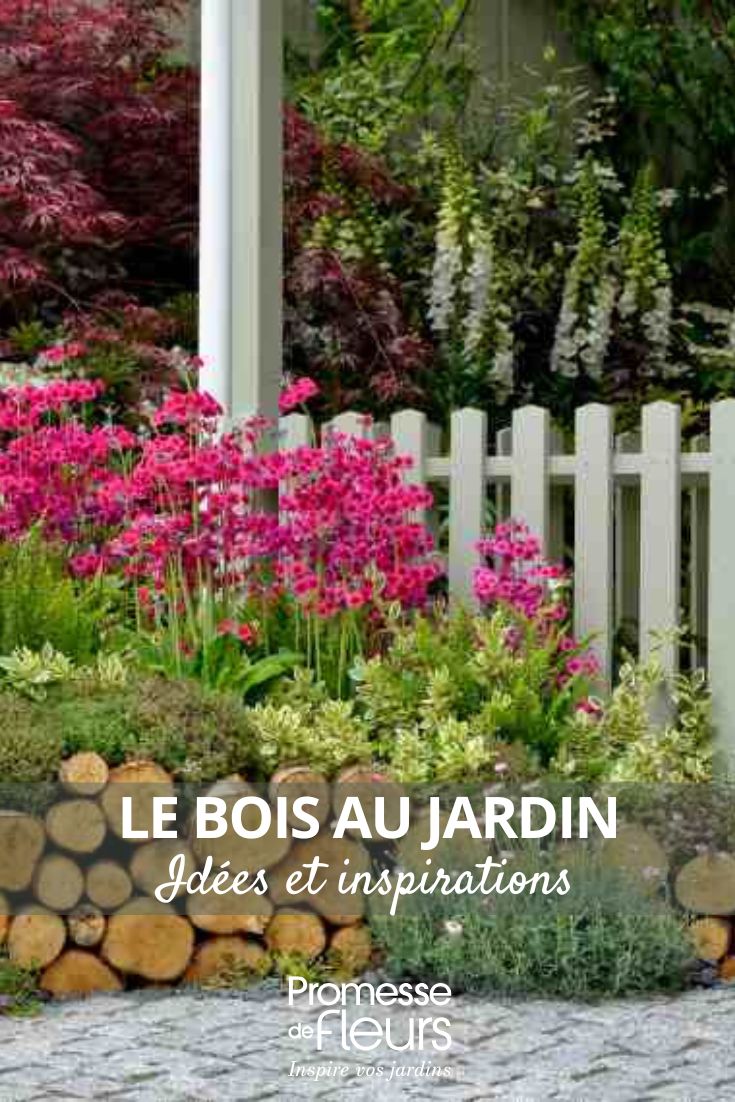































Comments